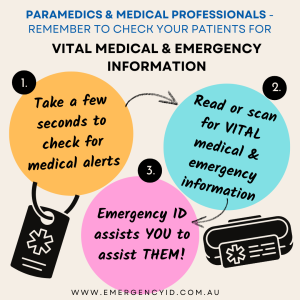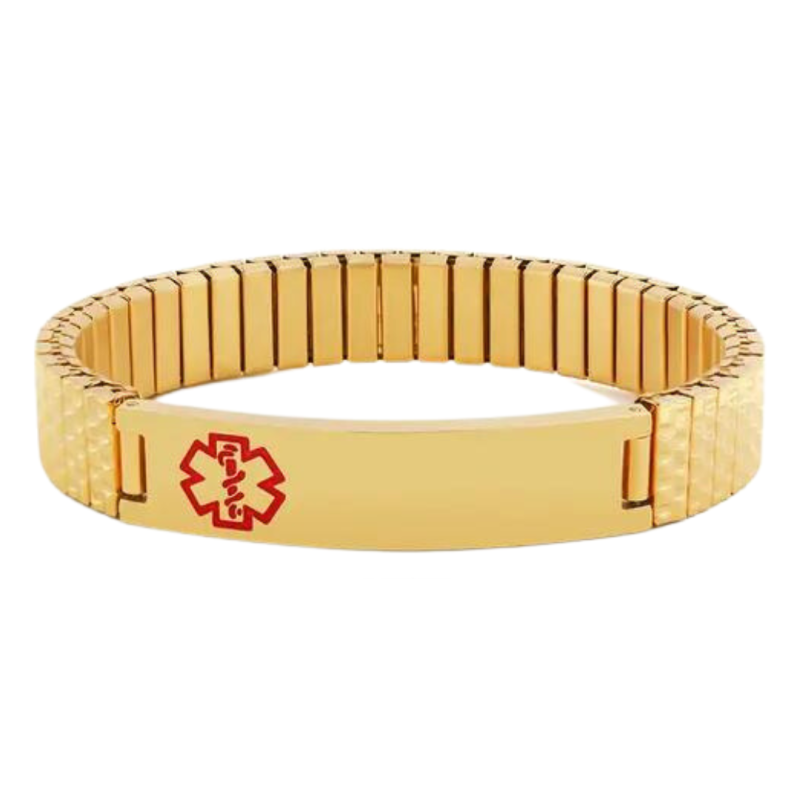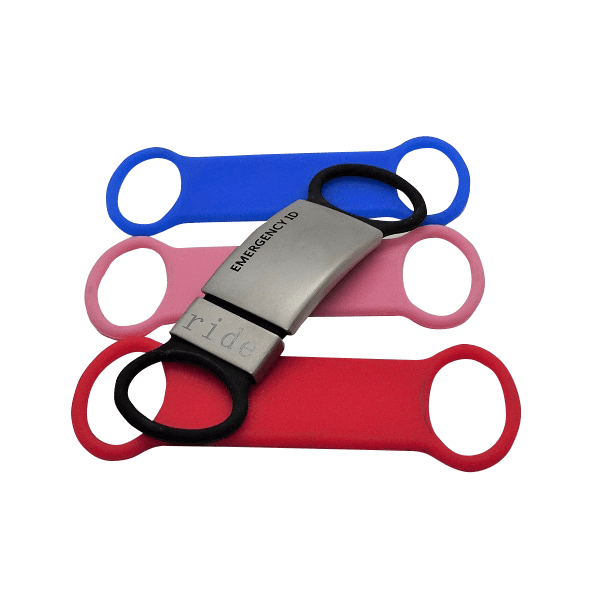*Info for Paramedics & Medical Professionals*

Taking a few seconds to check your patient for Emergency ID and medical alerts could provide you with VITAL medical & emergency information. Emergency ID assists you to assist them!
Perhaps they have a pre-existing Medical Condition? Allergies to medications you may give? Communication Difficulties? People wear and carry Emergency ID because they WANT & NEED you to know vital information about them and their care.
Paramedics and other medical professionals play a vital role in providing emergency medical care to patients. In order to ensure that patients receive the appropriate medical treatment, it is essential for medical professionals to check patients for emergency ID and medical alerts that relay vital medical and emergency information. In this article, we will discuss the importance of this practice and how it can benefit patients.
Emergency ID and medical alerts are typically worn as bracelets, necklaces, or other forms of identification, and they provide crucial information about a patient’s medical condition and emergency contact information. They can include information such as allergies, medical conditions, medication regimens, and emergency contact information.
One of the most important reasons why medical professionals should check patients for emergency ID and medical alerts is because it can help them make informed decisions about the patient’s medical care. For example, if a patient is allergic to a particular medication, this information can be easily and quickly communicated to medical personnel through the use of an emergency ID or medical alert. This can help prevent dangerous and potentially life-threatening reactions to medication.
Another important benefit of emergency ID and medical alerts is that they can provide valuable information about a patient’s medical history. This can help medical professionals understand a patient’s overall health and provide appropriate medical care. For example, if a patient has a history of heart disease, medical professionals can take this into consideration when assessing the patient’s condition and developing a treatment plan.
Emergency ID and medical alerts can also be useful in emergency situations where the patient is unable to communicate with medical personnel. For example, if a patient is unconscious or unable to speak, medical personnel can quickly and easily access important medical information through the use of an emergency ID or medical alert. This can help ensure that the patient receives appropriate medical care and can potentially save their life.
In addition to providing medical information, emergency ID and medical alerts can also provide important contact information for family members or loved ones. This can be particularly useful in emergency situations where the patient may not be able to communicate with medical personnel. By having access to emergency contact information, medical professionals can quickly notify family members or loved ones about the patient’s condition and provide updates on their medical care.
In conclusion, the importance of paramedics and other medical professionals checking patients for emergency ID and medical alerts cannot be overstated. These tools provide crucial information about a patient’s medical condition and emergency contact information, which can help medical professionals make informed decisions about their medical care. By taking the time to check for emergency ID and medical alerts, medical professionals can help ensure that their patients receive the appropriate medical care and potentially save their lives.
NOT checking could have fatal consequences.
………………………………………………………………………………………………………………
AMANDA’S STORY: A LIFE-THREATENING ALLERGY – Throughout the emergency, I was wearing my Emergency ID bracelet. No one looked at it, yet all the information was there!
“My name is Amanda. I’m 63, in excellent health, I run, swim, cycle, do weights and yoga. I have a wonderful life, love my family and I don’t want to die. If you saw me in the street, you’d say, why is this woman thinking about dying?
But I’m forced to think about dying, because I have an invisible illness. I have a life-threatening allergy to a chemical used as a filler in countless products, from junk food, to cheap cosmetics, over-the-counter medications, prescription medications, and vaccines.
The chemical is called polyethylene glycol, or PEG. It’s also called MACROGOL, and for people like me, it’s lethal. I am only too well aware that this chemical is poorly recognised in Australia, although its toxicity is recognised overseas.
Every day I am at risk of exposure, and every day I wear an Emergency ID bracelet. It’s my insurance.
But the story I’m about to share illustrates what happens if medical personnel won’t read the bracelet. 18 months ago, I was prescribed a medication by my doctor. I was worried but believed my doctor knew best, so took the pill. I didn’t know the antibiotic was filled with polyethylene glycol.
It takes my body around 12 hours to break this chemical down into its toxic components, but soon I became desperately unwell with neurological symptoms, including slurred speech, impaired hearing and vision, hallucinations, and unimaginable skull pressure. My brain was inflamed and swelling fast.
My husband was terrified as I was in and out of consciousness, so he called an ambulance.
The attendant was lovely. With all the kerfuffle of his arrival, I regained semi-consciousness and was able to respond to his questions. I told him I was having a dangerous reaction to an antibiotic.
Oh, it couldn’t be that, he said. What was the antibiotic for? Sinus infection. Oh, right, your sinuses are playing up! My husband and I continued to plead with the officer, but he was sure he had things right and wrote a note for the hospital, offering to drive me up.
I wouldn’t go. Uncertain if I would live or die, I was terrified of being given more PEG by someone else, as the ambo was unable to grasp the situation. Eventually, the ambulance left, and I stayed. I slept for hours. The following day I read the note he’d given me to take to the hospital. It said I had a sinus infection. No mention at all of the drug reaction. I could hardly believe it!
The intracranial swelling I experienced that day caused a brain injury I had to live with for the next year. It was hard going, and some symptoms still linger even now.
And throughout this entire emergency, I was wearing my Emergency ID bracelet. No one looked at it, yet all the information was there!
Just think about that for a moment.
Much more recently, I ate a bad pizza and got food poisoning. I was pretty ill and once again in and out of consciousness. When I passed out, my husband didn’t know what to do.
Should he call an ambulance? Would they read my bracelet this time?
As I came around again, he asked me what I wanted. In agony, I sobbed
NO AMBULANCE, NO PEG.
So we didn’t call for help that night, and I pulled through. I was lucky.
But a few days later, to allay my anxiety about ambulance crews, I called AMBULANCE Tasmania and asked if they could assure me that the chap who didn’t read the bracelet that time was an anomaly, maybe new to the job.
To my horror, the person I spoke to advised me that reading medical alerts was hit-and-miss and not to rely on it. Not to rely on it???
But this bracelet has vital information which takes only seconds to read! It says I must not be given any medication without a filler check. It even has the TGA website, so a check can be done on the spot. So easy!
Why would medical personnel not take a moment to read this?
I’d like to finish with one final message: I once bought a tin of paint to paint my ceiling. A funny little message on the label. IF ALL ELSE FAILS, READ THE INSTRUCTIONS, it said.
Simple, right? Read the instructions. For me and thousands of others, the instructions are on the bracelet. Please read the instructions.
It might save my life, and the lives of countless others. Read the bracelet”.
………………………………………………………………………………………………………………
APPROX 2.6 million PEOPLE DIE EACH YEAR DUE TO MEDICAL ERRORS
Medical errors are a significant problem worldwide, and here are some statistics:
- According to the World Health Organization (WHO), an estimated 2.6 million people die each year due to medical errors worldwide.
- A study published in the Journal of Patient Safety in 2013 estimated that medical errors cause as many as 440,000 deaths in the United States each year.
- In the United Kingdom, a study published in the British Medical Journal (BMJ) estimated that medical errors contribute to 12,000 deaths each year.
- In Australia, it is estimated that medical errors cause 18,000 to 54,000 deaths annually.
- In Canada, a study published in the Canadian Medical Association Journal estimated that medical errors cause more than 23,000 deaths each year.
- In low- and middle-income countries, medical errors are a significant problem due to resource constraints and a lack of patient safety protocols. A study by the WHO estimated that four out of ten patients are harmed in primary and ambulatory care settings in these countries.
In summary, medical errors are a global problem that affects patients in all countries, with estimates of the number of deaths and adverse events varying depending on the country and the study methodology. Improving patient safety and reducing medical errors are critical global health priorities.
Medical errors are a significant problem worldwide, but it is challenging to determine their exact frequency. The World Health Organization (WHO) estimates that globally, medical errors cause hundreds of thousands of deaths annually. However, the exact number of medical errors is challenging to measure because not all errors are reported, and some may go undetected.
Several studies have tried to estimate the prevalence of medical errors. For example, a 2016 study published in The BMJ found that medical errors are the third leading cause of death in the United States, with an estimated 251,454 deaths annually. Another study published in the Journal of Patient Safety in 2013 suggested that medical errors could cause as many as 440,000 deaths in the US each year.
Outside of the US, there are fewer estimates of medical error prevalence, but evidence suggests that medical errors are a problem in many countries. For example, a 2012 study in England estimated that adverse events occur in around 10% of hospital admissions, and half of those events are preventable.
In summary, medical errors are a significant problem worldwide, but it is difficult to determine their exact frequency. However, evidence suggests that they cause a significant number of deaths and adverse events each year.
Wearing Emergency ID medical alerts can reduce medical errors Emergency ID Australia : Shop Medical Alert IDs
Emergency medical services
Paramedic care
Ambulance services
Mobile intensive care unit
Medical transport services
Emergency response team
Medical emergency response
Emergency medical care
First responder services
Medical alerts
Emergency ID
Medical history tracking
Patient information management
Emergency contact information
Medical condition tracking.
.
Showing all 2 results







